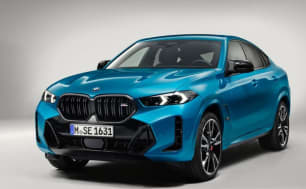You know you’re in a large SUV when you slide into the X6 because the cabin has a lot of space in both rows.
But also because of the higher centre console design, you feel tucked into the car despite the higher seating position. It makes it feel far sportier than your typical SUV.
Even back rowers enjoy decent legroom and headroom, despite the panoramic sunroof and sloping roof design. Six-footers should be relatively comfortable in both rows but it's best to reserve the middle seat as a sometimes position for adults. The raised floor won’t allow true comfort for a longer trip.
Let’s chat luxury because there’s plenty to be had with the electric front seats and their cloud-like comfort.
The electrically-adjustable side bolsters and adjustable lumbar support makes it feel like you’re being cuddled by the seat and also hold you in place in a turn. The extendable under-thigh supports minimise leg fatigue on a longer trip.
However, the back seat is almost as comfortable as the fronts in terms of cushioning. You also sit in, rather than on top of the seats which is a nice change for an SUV.
Individual storage is great in both rows and up front you get a dual-opening middle console, glove box and a handy utility area that houses the cupholders and two phone pockets.
There is also a storage nook on the driver’s side that will comfortably hold a wallet.
In the rear you enjoy two map pockets on the front seat backs and retractable cupholders in the fold-down armrest.
The armrest houses a shallow device holder and sits at a good height. Both rows enjoy deep storage bins in each door and a large drink bottle holder.
Happily, the holder is tilted towards the user, rather than away which is what you usually see.
The boot is a great size at 580L with all seats in use. There’s a little lip that has practical metal scuff plates but otherwise the loading space is level.
The hands-free powered tailgate is welcome and the handy 40/20/40 split on the back row opens up your storage options.
You get a temporary spare tyre underneath the floor and it’s cool how the floor has a gas strut, which makes the area much easier to access.
The concertina-style cargo cover is a bit dicky to use but I like how solid it is. It could easily double as a shelf by itself.
Charging options are abundant with a total of two 12-volt ports, a USB-A port, three USB-C ports and a wireless charging pad to choose from throughout the car. But it is annoying to use the pad when the front cupholders are in use.
I like having hardened kickplates on the backs of the front seats because my seven-year old loves putting his feet on everything.
The higher ground clearance makes this an easy car to get in and out of but it also makes for a great view for my son. He finds the doors a little heavy to close but the massive door grab handles help!
Amenities in the rear row make it a pleasant space to be in for kids and adults alike. You have reading lights, map pockets, two storage shelves and directional air vents.
There is manual climate control in this row, too, but it feels at odds with the rest of the high tech in the car.
On that note, the updated technology looks gorgeous.
The head-up display is clear and the digital instrument panel offers plenty of customisation. It's a super handy feature to access your recent call log via the steering wheel controls and see it pop up on the instrument cluster.
The touchscreen multimedia system is responsive but you can also use the rotary dial to get around it. There is a stack of information in it, though, which will take a bit to get your head around. Can’t fault its graphics, it looks hot, but some users may feel flustered at first.
The system has built-in satellite navigation that features an augmented reality feature, which overlays dynamic instructions on the video feed. What makes it practical is how it can be viewed on your instrument cluster, which means more on-road focus for the driver.
There is wired Android Auto and wireless Apple CarPlay, with the latter being simple to connect to. You don’t have the important climate control buttons/dials up front and I find it annoying to access the multimedia screen to change climate and fan speed settings.
What you lack in controls there is more than made up for in the centre console. There are a lot of buttons, from the push-button starter, rotary control wheel and everything in between.
Even after a week, my mind still has a mini freeze looking at them while on the go.










.png)




.png)














.png)

.png)


